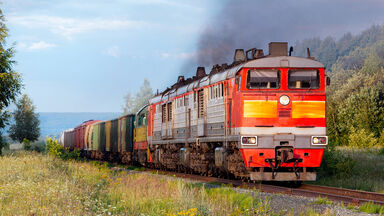Multiplying through by w we obtain Tw = 2FwD = 2µWwD = RV (4) This is a fundamental energy equation for any form of locomotive in which there is only one driving-axle.
The fundamental difference between the two methods is that while the mechanical energy developed by a steam engine is in the first case applied directly to the driving-axle of the locomotive, in the second case it is transformed into electrical energy, transmitted over relatively long distances, and retransformed into mechanical energy on the driving-axles of the train.
In the second case every axle in the train may be made a driving-axle if desired, in which case the locomotive as a separate machine disappears.
The horsepower available at the driving-axle, conveniently called the brake horse-power, is from 20 to 30% less than the indicated horse-power, and the ratio, B.H.P./I.H.P. =E, is called the mechanical efficiency of the steam engine.
The relation between the b.h.p. and the torque on the driving-axle is 55 o B.H.P. =Tu., (9) It is usual with steam locomotives to regard the resistance R as including the frictional resistances between the cylinders and the driving-axle, so that the rate at which energy is expended in moving the train is expressed either by the product RV, or by the value of the indicated horse-power, the relation between them being 55 0 I.H.P. =RV (Io) or in terms of the torque 55 0 I.H.P.X€=RVe=TW (II) The individual factors of the product RV may have any value consistent with equation (to) and with certain practical conditions, so that for a given value of the I.H.P. R must decrease if V increases.





